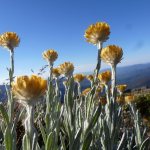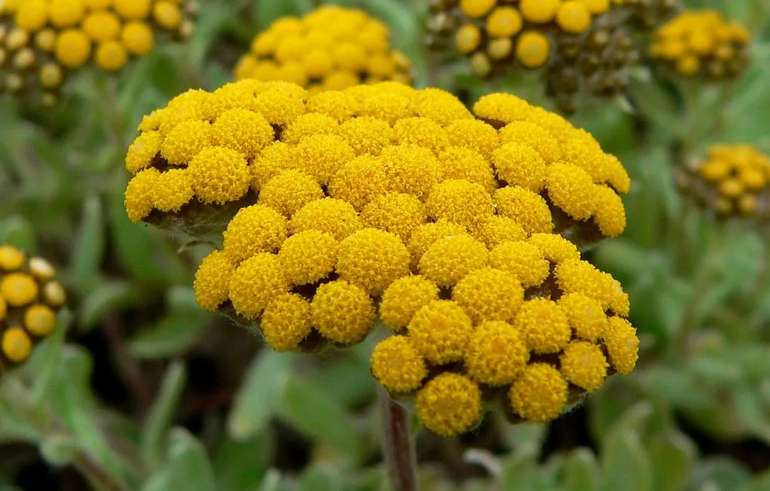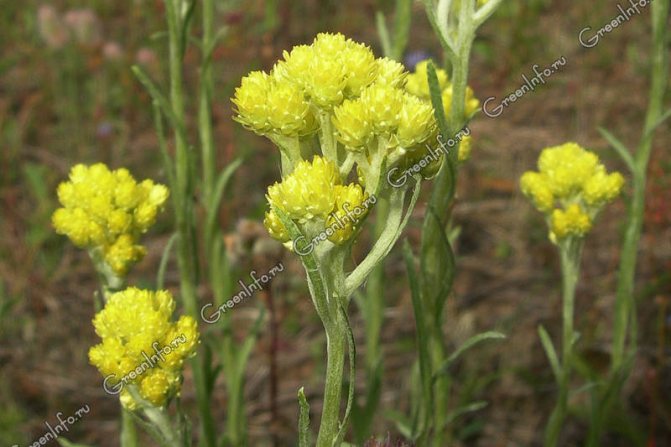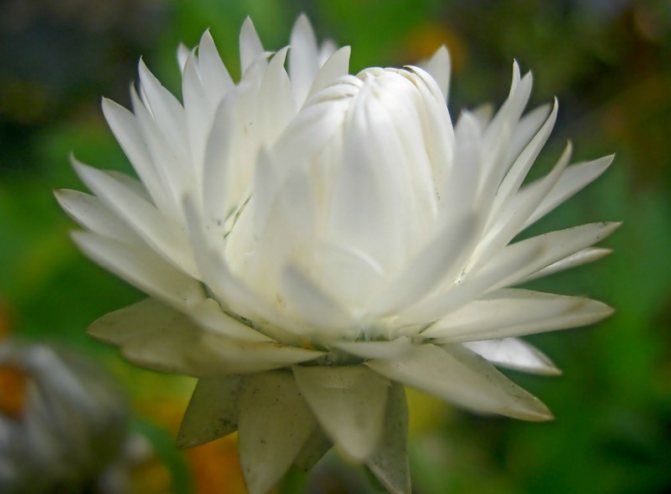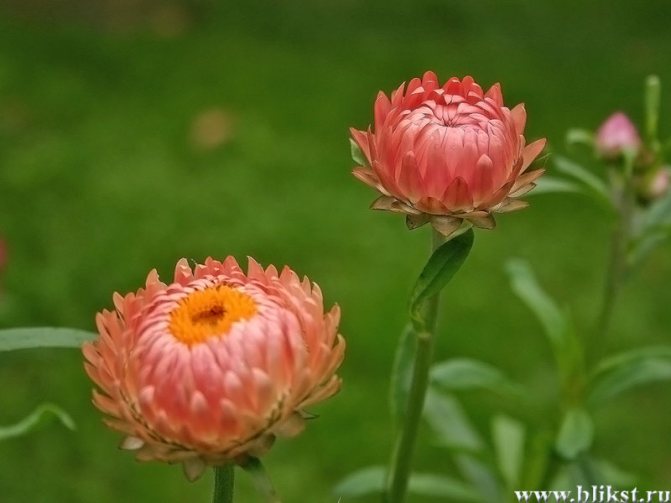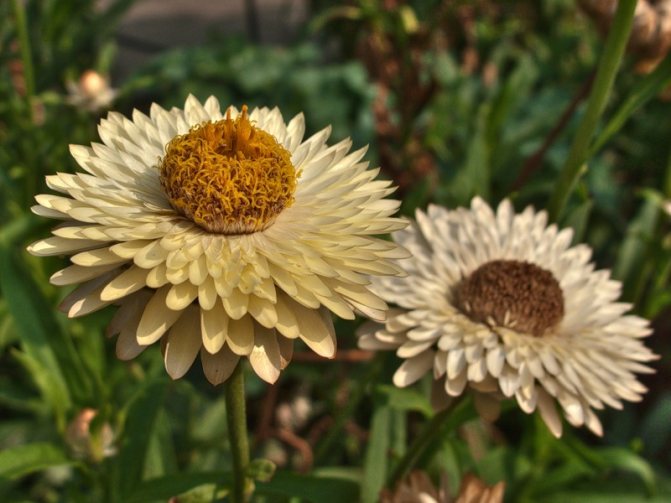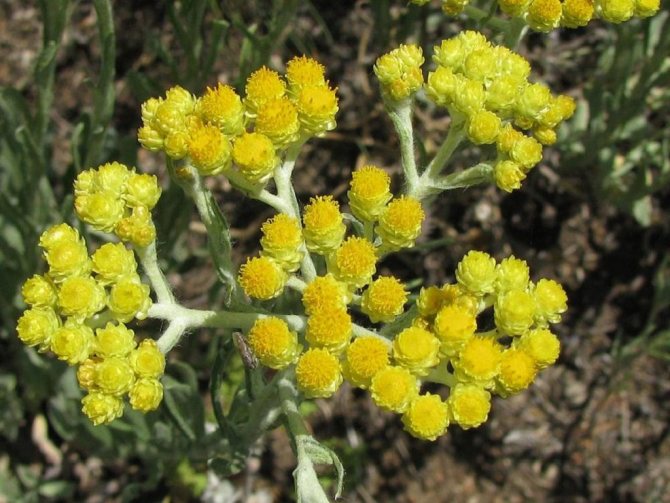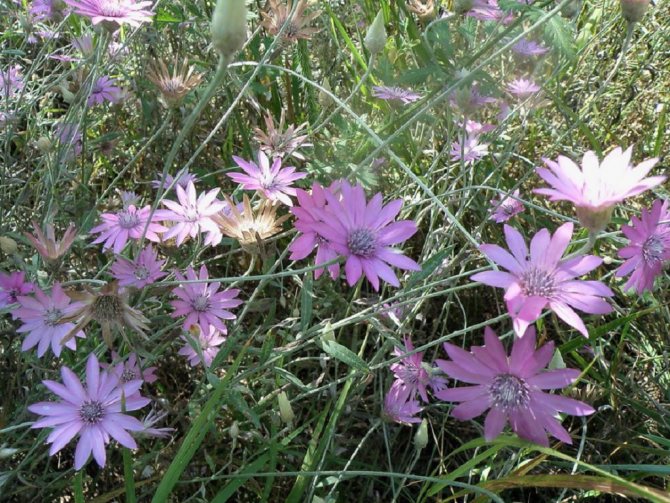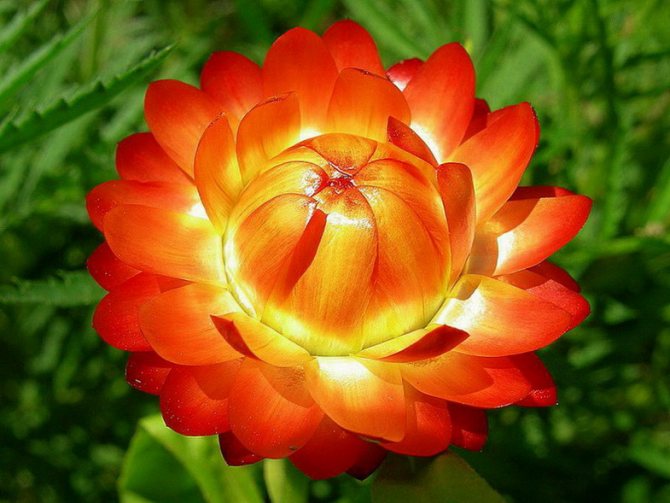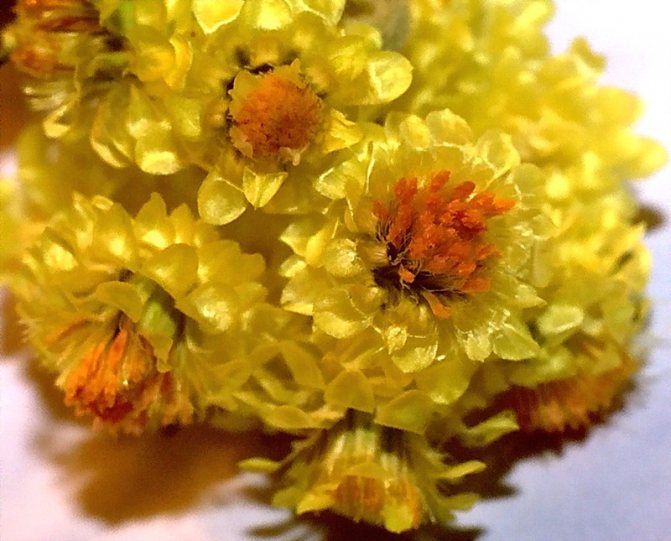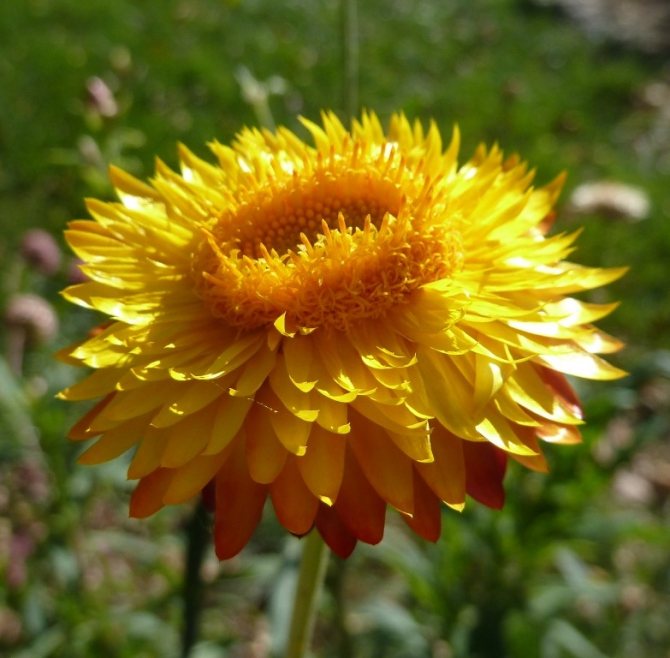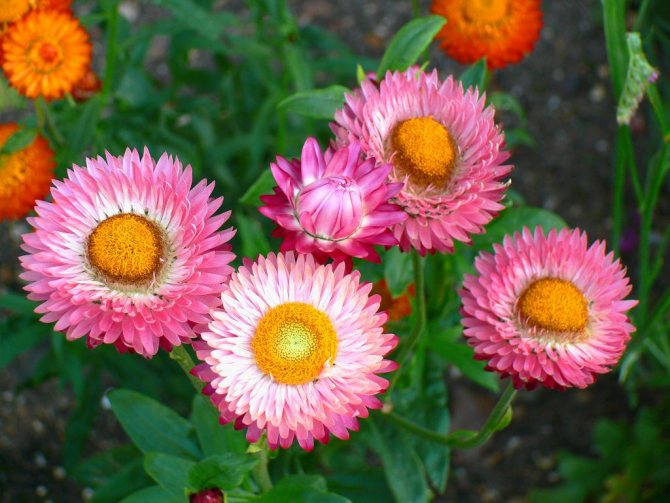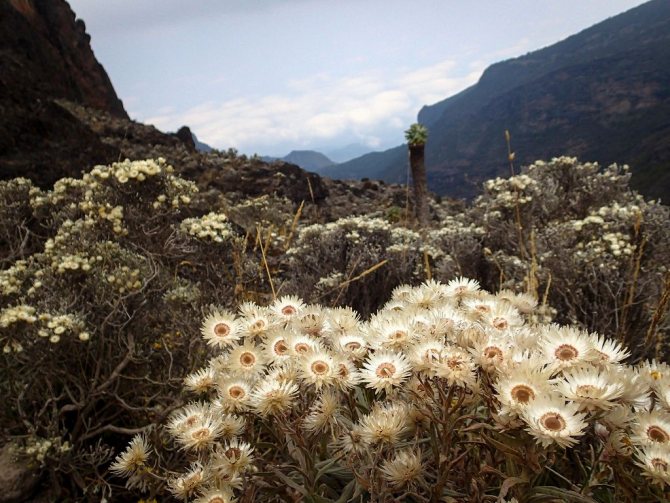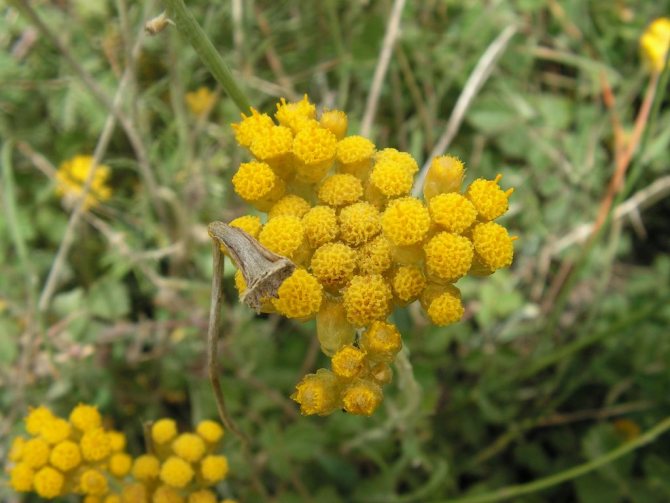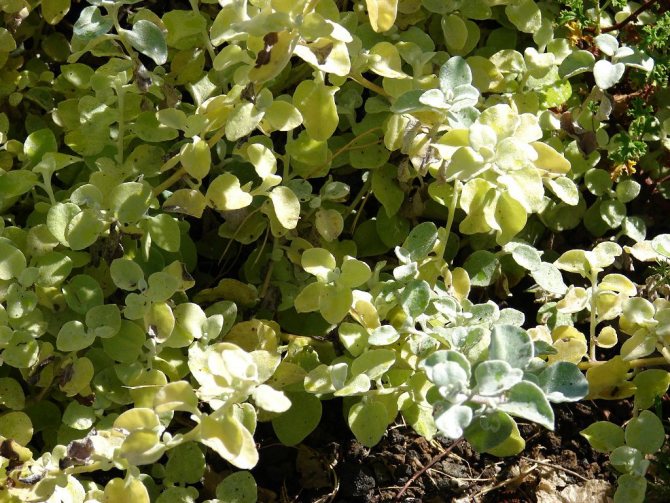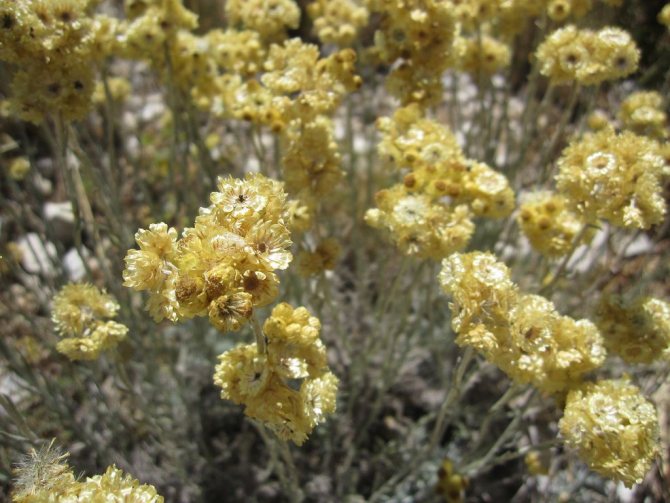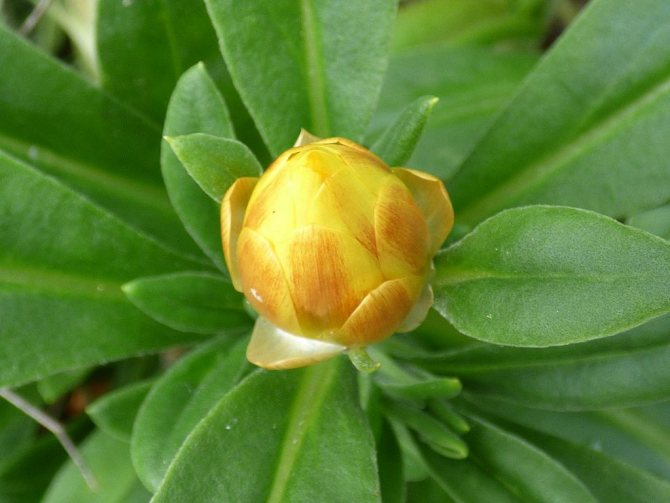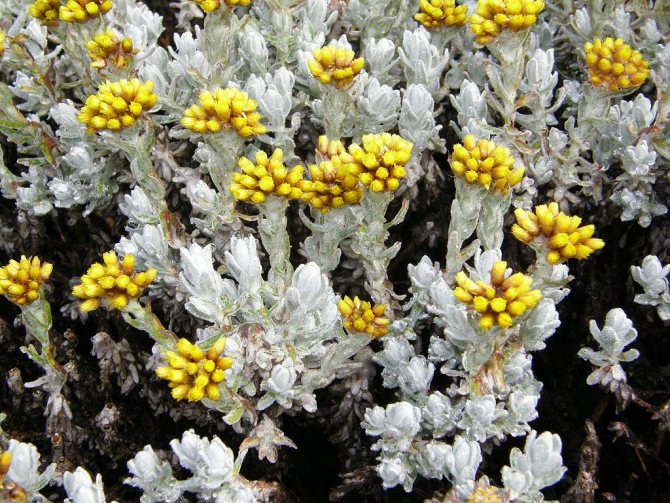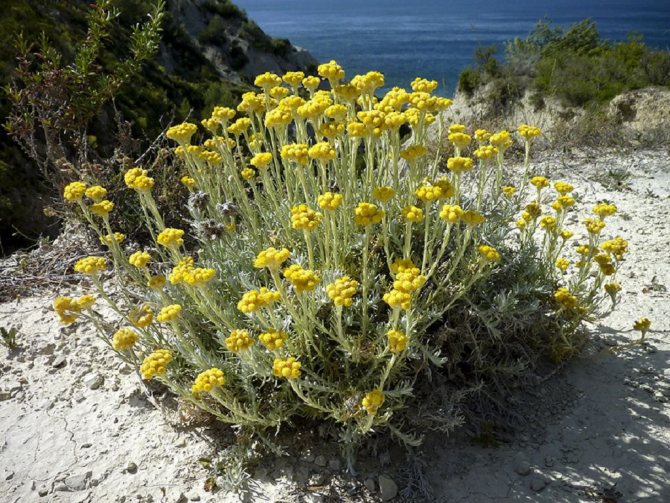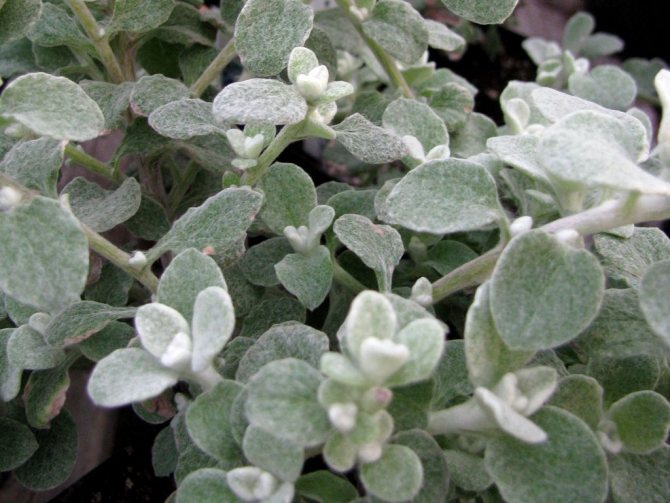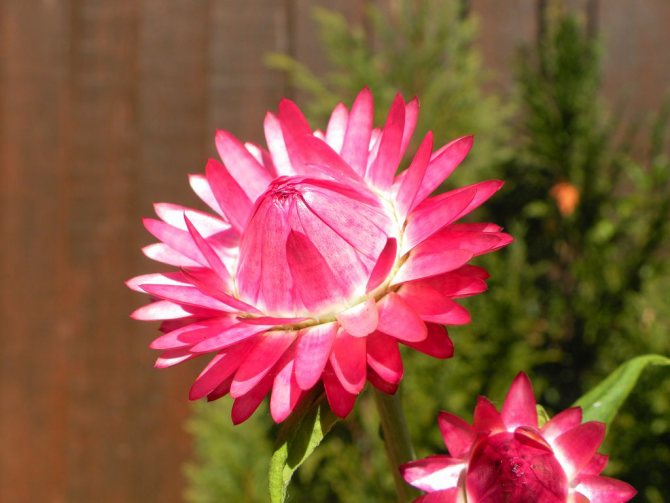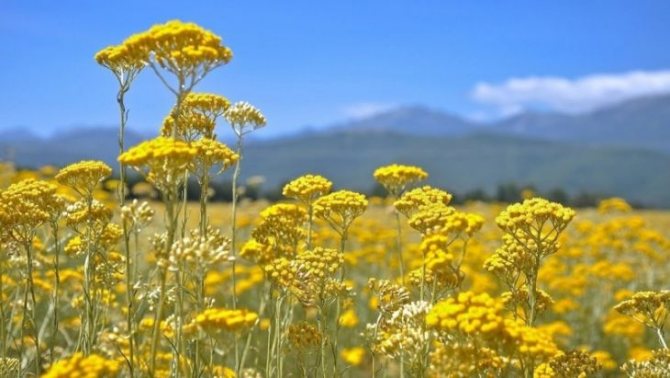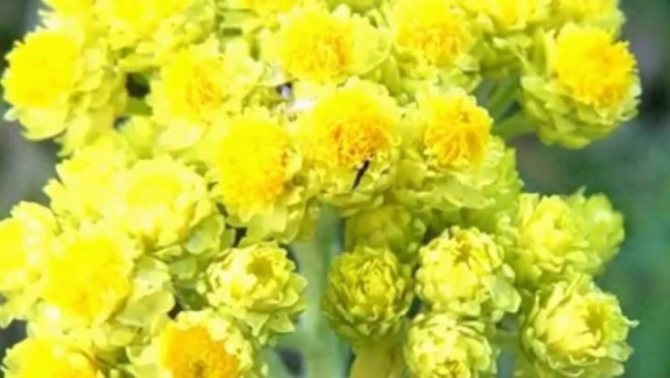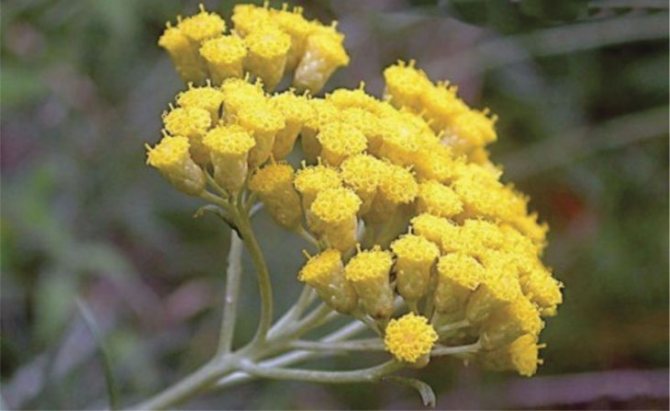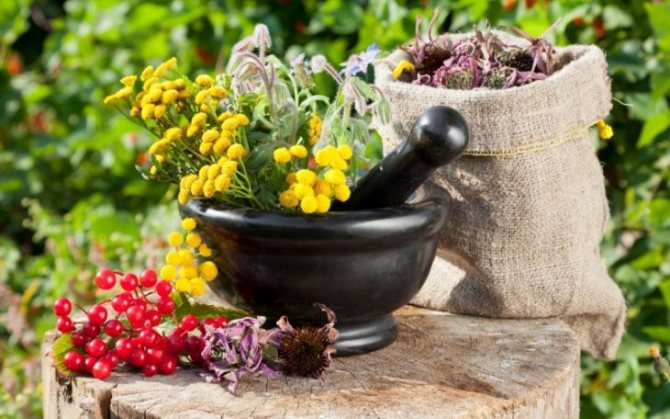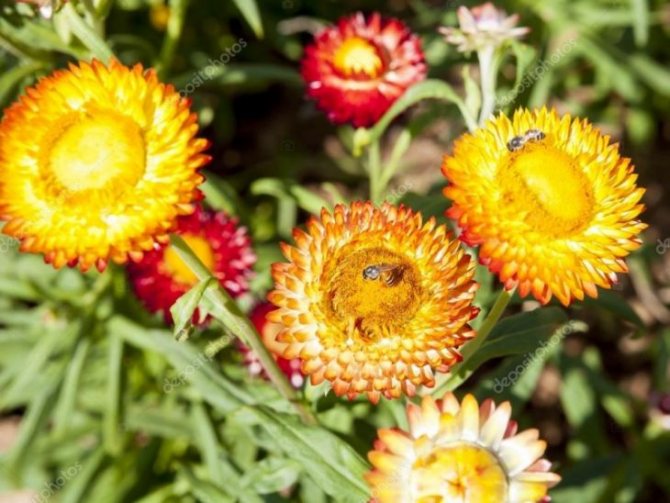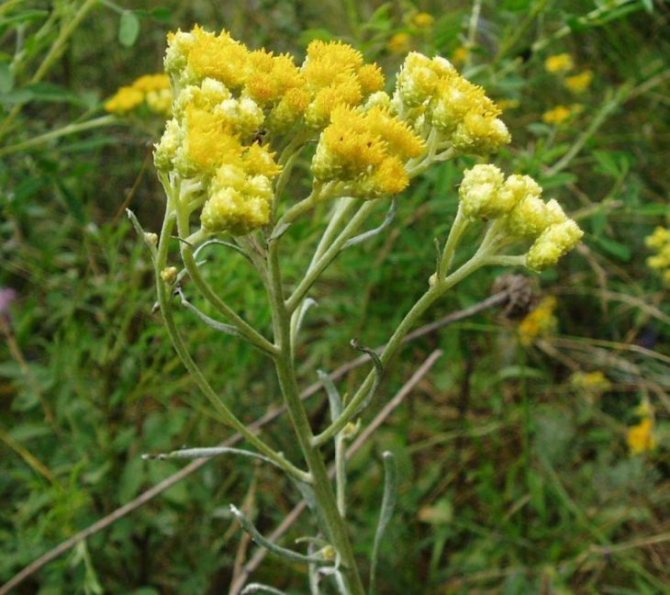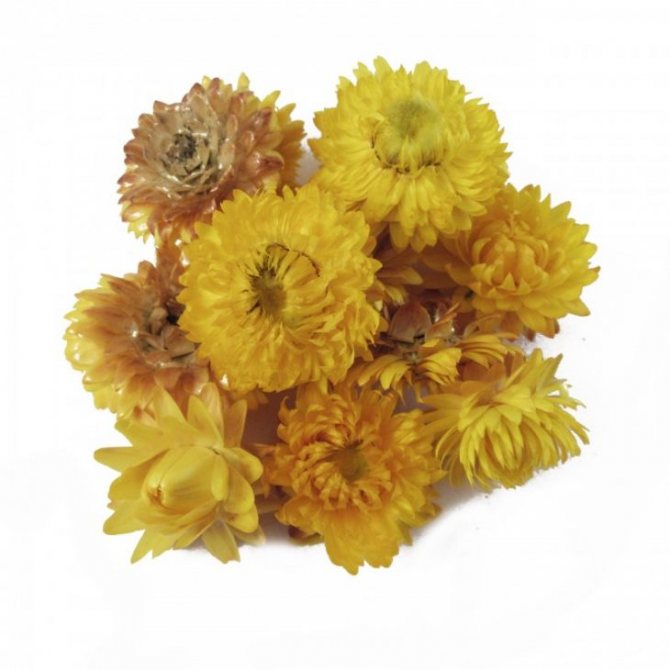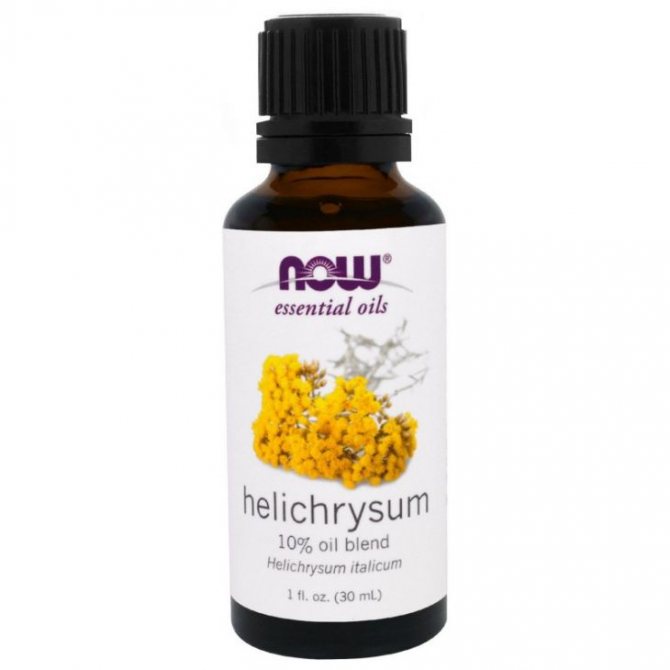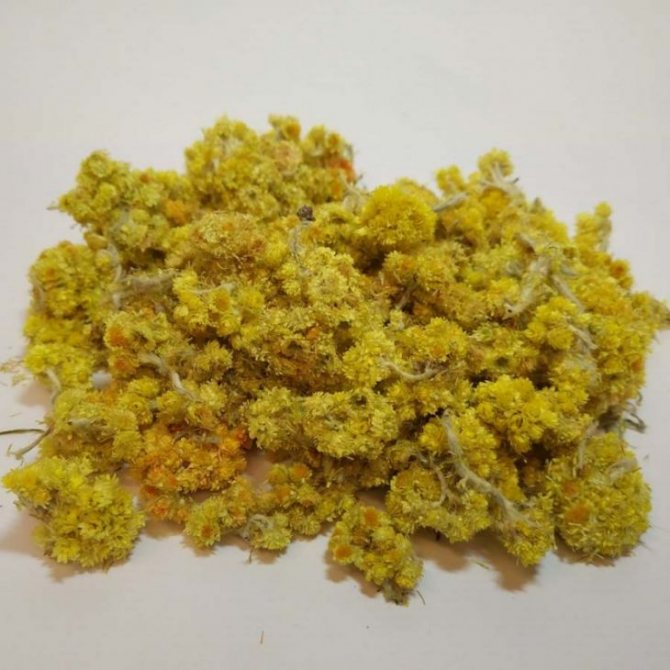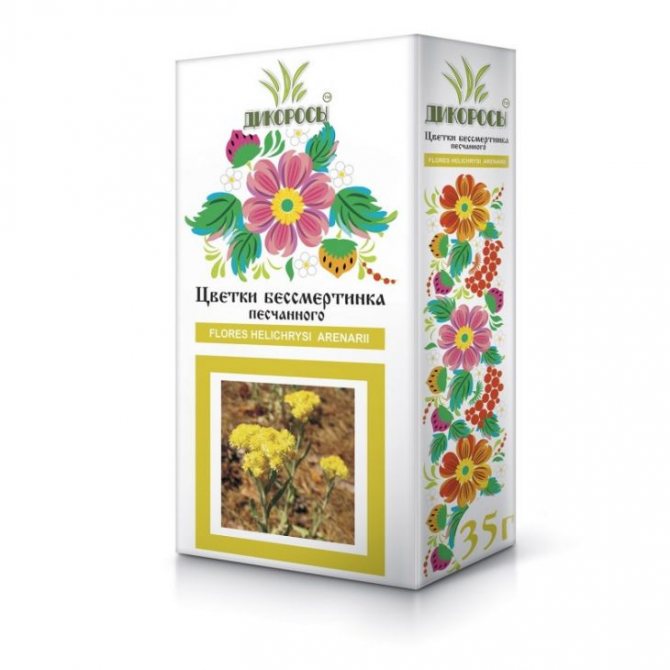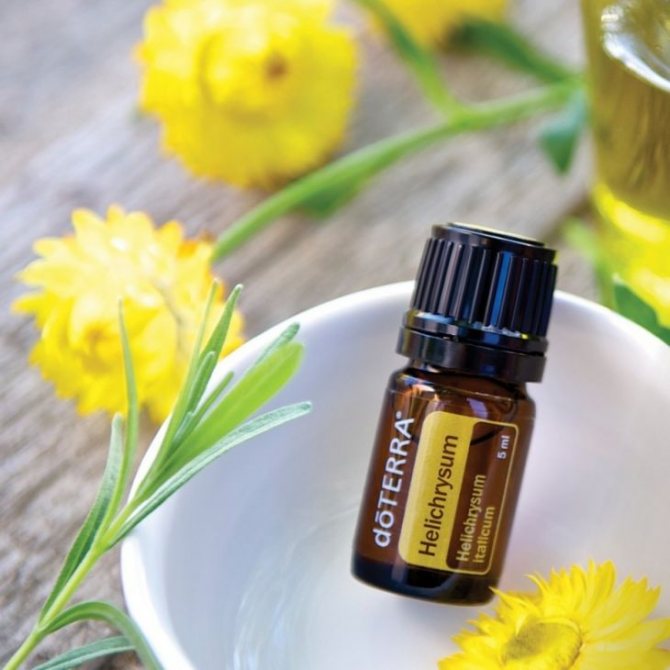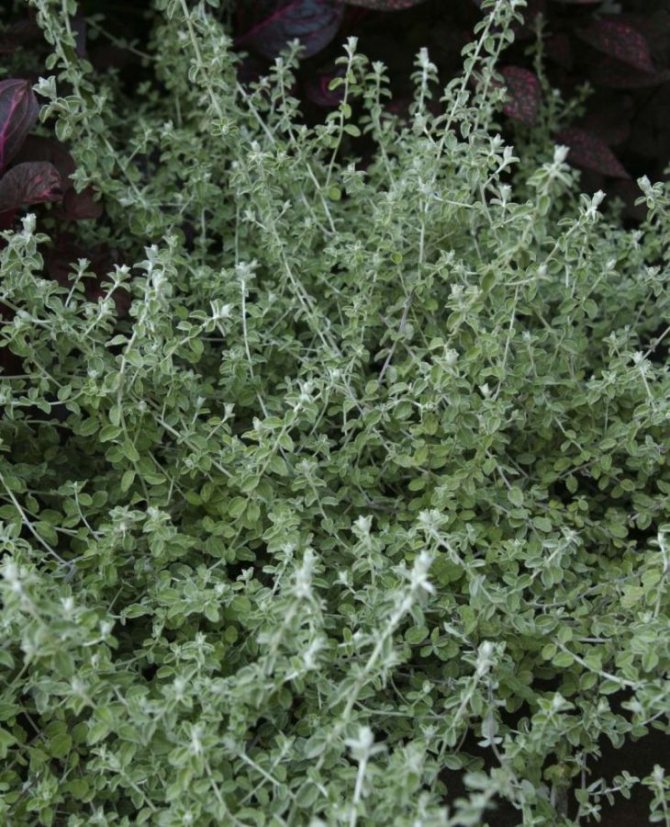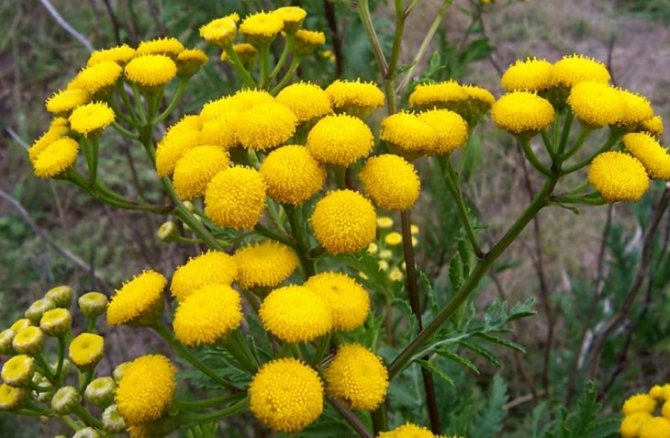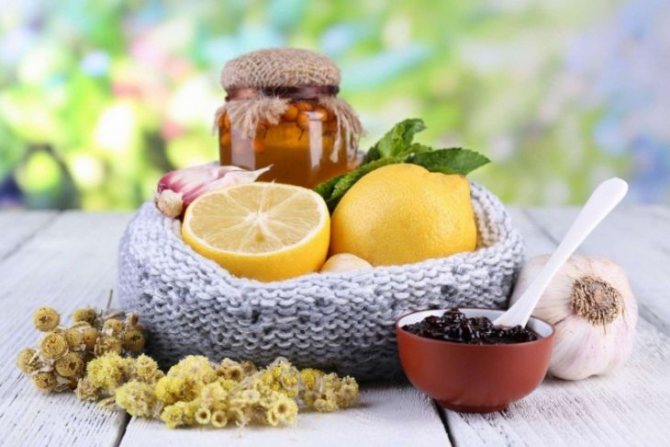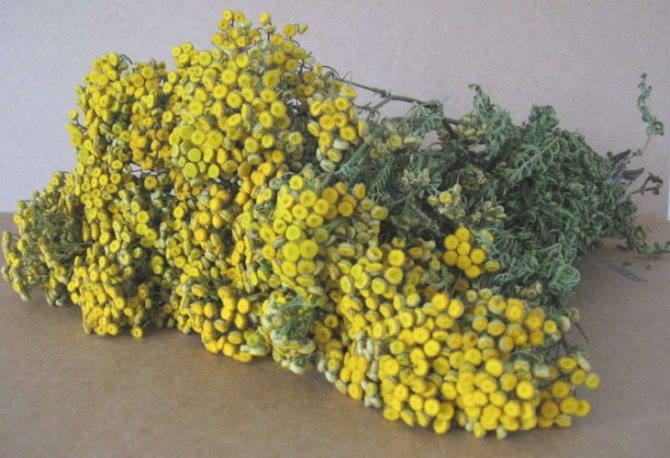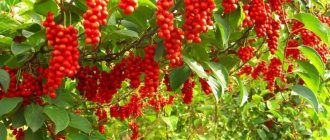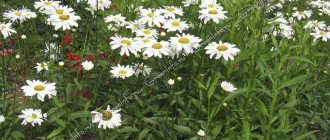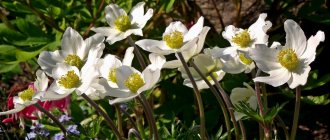Immortelle, gelikhrizum, tsmin, zheltyanka - all these names correspond to one plant - a herbaceous perennial from the Astrovye family. Its branchy shoots are decorated with bright inflorescences with small, rigid buds, which retain their beauty for a very long time, even when dried. The native land of the plant is Africa (Madagascar Island and Cape region), as well as Australia and Asia Minor. The immortelle is actively used in floristry, landscape design and medicine. Its genus is quite numerous, which makes it possible to compose a bright and rich composition. It is enough just to follow a few simple rules and find a suitable place for a flower garden.
Varieties and types
Gelichrizum bracts - is a perennial tall herb. The immortelle has branched and straight stems reaching a height of up to 80 centimeters. It has dark green lanceolate leaf plates. The plant blooms from July to October. Its inflorescences are basket-shaped. On the peduncle there are six flowers of white, red or orange hue.
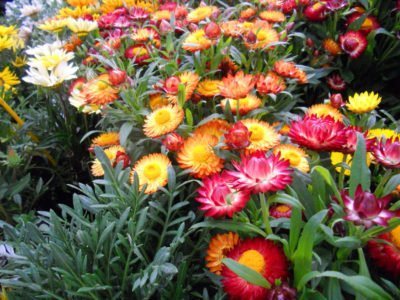
Gelikhrizum petiolate - this variety is appreciated due to the decorative foliage. The plant has long, branching stems. The plant has round or oval leaves with bluish, yellow or bright green color. The outer part of the leaf plates is covered with silvery villi. In the northern part of the country, the immortelle does not bloom, in the south, nondescript flowers of a gray-yellow hue appear on the plant.
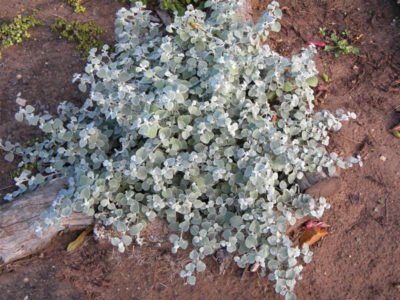

Gelichrizum arenarium - the plant has a simple straight stem, reaching 40 centimeters in height. It has small leaf plates, 2 to 6 centimeters long. Inflorescences look like small spherical baskets with 10-30 yellow or orange flowers. The immortelle of this variety is used in landscape design and in medicine.


Gelikhrizum terry - is a fairly common species, reaching up to 1 meter in height. Up to 25 inflorescences are formed on the bush, the diameter of which is up to 7 centimeters. Flowers can be white, yellow, red, orange and pink. It can be planted both in flower beds and in pots.
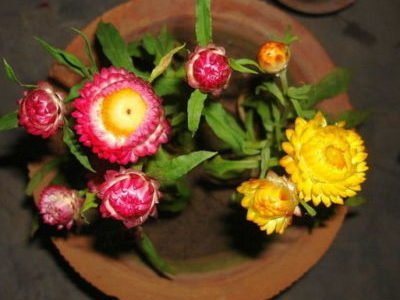

Gelichrizum Swiss giant
The immortelle has a straight stem, reaching a length of 40 centimeters. Terry flowers of a basket-like type of red, white, lemon, brown, pale pink, orange and yellow shades. Tsmin of this variety is suitable for decorating flower beds and mixborders. When dried, the flowers do not lose their bright and rich color.


Gelichrizum silver - the plant has creeping shoots with pale green pubescent leaves. When it hits the sun-colored cmin, it casts silver. Thanks to this effect, it got its name. In the northern latitudes, the plant does not bloom, but in the south it is covered with pale yellow pleasantly smelling small inflorescences.


Gelikhrizum perennial - the stems of the plant reach a length of 40 to 60 centimeters. The leaf plate has a lanceolate shape from 3 to 7 centimeters in length. Inflorescences are basket-shaped with dry petals of white, yellow, horny, red or crimson hue. There are also varieties with blue flowers. The flowering time for cmin is early summer and lasts until mid-autumn.
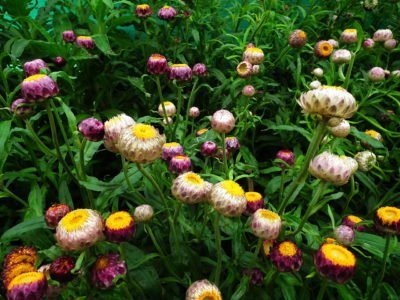

Gelikhrizum italian - the immortelle has medium-sized stems up to 60 centimeters high. The leaves have a strong, pleasant aroma reminiscent of Indian curry. The flowers have a bright yellow tint. This type of cmin is used in cooking, medicine and perfumery.
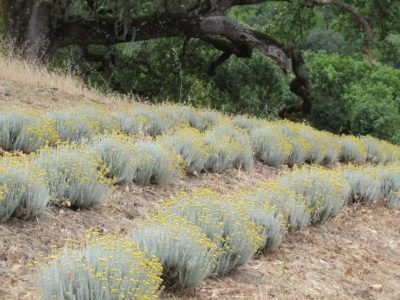

Sandy immortelle - is the only plant species that grows in our steppes and has a height of about 15 centimeters. The stems of the cmin are dense, and the leaves resemble thorns. Gelichrizum flowers are small, bright yellow with a spicy aroma. It is extremely easy to grow it in garden conditions, since the plant does not need painstaking care.


Botanical description
The immortelle is a perennial, but sometimes an annual plant with branched shoots. It forms a shrub or semi-shrub with an openwork crown. A short and weakly branched rhizome is located underground. Growth height ranges from 30 cm to 120 cm. Erect stems along the entire length are decorated with narrow alternate foliage. Only at the base can the leaves grow oppositely and be larger. The color of the lanceolate leaves is usually dark green. There is a short pile or coating on the surface that does not allow moisture to evaporate too quickly.
The flowering period is from July to September. At this time, inflorescences-baskets with a diameter of 4 mm to 7 cm bloom on the tops of the stems. They contain small, like threads, tubular bisexual flowers. They are surrounded by bright petals (wrapper). At the beginning of flowering, the inflorescences are very dense, almost capitate. They become looser over time. The color of the petals is dominated by bronze, pink, yellow, violet, red colors and their shades. The smallest baskets are most often collected in more complex umbellate inflorescences.
The plant is pollinated with the help of insects. After that, oval, prism-like seed pods ripen. Their surface is woolly, and at the top there is a single-row crest.
Gelikhrizum planting and care in the open field
The immortelle is an unpretentious culture, but in order for it to bloom for a long time and abundantly, it should not only choose the right soil for it, but also the site for planting.
Tsmin loves the sun very much, therefore, when looking for a place for its disembarkation, you should choose a garden bed that warms up well and is illuminated by the sun's rays.
By the way, the plant tolerates drought very well, but at the same time its watering plays an important role in the growth and development of the flower.
Planting of young plants grown from seeds is carried out in mid-May. This time is chosen for the reason that the young animals do not get frozen and are not destroyed.
When planting plants, leave at least 25 centimeters of free space between them. Drainage and peat should be added to the planting holes. The planted plants begin to bloom around mid-summer.
Bodyak is also a representative of the Astrov family. Grown when planting and nursing outdoors. Although the plant is considered a weedy, it still has medicinal properties. All the necessary recommendations for growing and using this plant, as well as measures to combat it in the garden, you can find in this article.


Sandy immortelle, or sandy cmin (Helichrysum arenarium)
All my childhood and school years, this plant grew on our estate in Millerovo. When and how we got it, I don't remember. Its main advantage was its choleretic properties. Previously, sandy immortelle, like creeping thyme (Thymus serpillum), was called Bogorodskaya grass, flea beetles, yellow hornbeam, scrofula, cat's paws, dried flowers.
Sandy immortelle. Photo from the site
Herbaceous tomentose-woolly perennial up to 30 cm high. Leaves are simple, with a brownish tip at the top.Inflorescences-baskets are spherical, the envelope consists of an average of 45 lemon-yellow (less often orange) leaves with a wide filmy edge; blooms in June-August. Now he has a variety with larger inflorescences - ‘Golden’.
Sandy immortelle near a stone wall. ‘Golden’ variety.
The nuances of growing Unlike its thermophilic relatives, it is frost-hardy: it can endure -30 ° C for a short time. Extremely drought tolerant. A true ascetic about the soil is content with the poor.
Accommodation in the country It is as if nature specially created it for rockeries, flower walls. Sandy immortelle looks beautiful among and against the background of stones.
Soil for gelichrizum
The soil for cmin must be fertile and light, despite the fact that in the wild it grows in poor soil. The best option for planting would be sandy loam, chernozem or loam.
The main thing is to provide the plant with a good drainage layer so as not to allow moisture to stagnate at the roots. As for the acidity of the soil, it should be neutral.
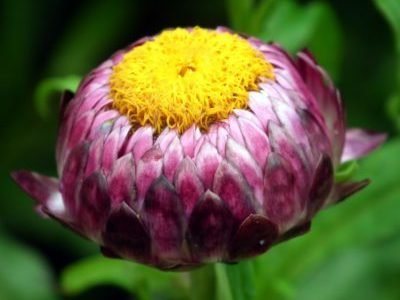

Petiolate immortelle (Helichrysum petiolare)
An evergreen perennial cushion-shaped subshrub that is grown as an annual. He is originally from South Africa.
Petiolate immortelle. Photo from the site .au
It is up to 50 cm high and up to 2 m wide. The leaves are cordate, small, 3.5 cm long, silvery-gray, densely pubescent. The capitate inflorescences of cream flowers are inconspicuous. Decorative varieties:
- 'Aurea', syn. ‘Limelight’ - pale green leaves, lime;
Petiolate immortelle 'Limelight'. Photo from the site
- ‘Roundabout’ - miniature, 15 cm high and 30 cm wide; descended from 'Variegatum', therefore often produces variegated shoots;
- ‘Variegatum’ - leaves are gray, with a creamy irregular border.
'Roundabout' petiole immortelle. Photo from the site blabus.pl. Petiolate immortelle 'Variegatum'. Photo from the site The nuances of growing It grows both in the sun and in the shade. Requires well-drained soil; tolerates dry conditions, but may die in very wet areas. In Russia, its seeds can be found on sale marked "supernova from Italy."
Accommodation in the country In southern dachas, it can be used as a silvery ground cover plant, ampelous, hanging beautifully from a low wall or stationary container. It is good in company with other drought-resistant species: lavender, catnip, monarda, and so on. It tolerates pruning well: it can be formed in a semicircle, but the compact shape can only be maintained with garden shears.
Fertilizer gelichrizum
The annual cmin does not need frequent feeding, since fertilizers are applied when planting in the ground. In order for the plant to bloom until mid-autumn, it should be fertilized at the end of August with compost or fertilizer for flowering plants.
Perennial plants should be fed more frequently. The first feeding is carried out in the spring, then several times in the summer and once in the fall. As fertilizer, you can use compost or universal top dressing. Throughout the entire flowering period, the land around the bushes must be loosened and weeded.


Italian immortelle (Helichrysum italicum)
My favorite plant, so I really want it to return to the flower beds. Even 35 years ago, when I first arrived in Yalta, I saw him in the mixborders of the South Coast quite often. It was actively propagated and implemented by the Nikitsky Botanical Garden. It perfectly complemented lavender, rose, oleander. He was planted in rockeries among the stones.
Immortelle Italian, photo by the author
I already talked about this plant in the publication Italian in the Crimea. I like everything about this immortelle: graceful silvery stems and leaves, complemented by exquisite yellow inflorescences, a tart aroma with honey notes.
Growing fast.It has an interesting dwarf form, 'Dwarf', syn. 'Dwarf Form' (40 cm high, 60 cm wide), often referred to simply as curry. The fact is that the smell of its leaves is similar to the recognizable aroma of the famous seasoning, thanks to which 'Dwarf' is especially in demand today.
Italian immortelle 'Dwarf'. Photo from andre-briant.fr. It's in a stationary container. Photo from the site
The nuances of growing My favorite prefers warmth, tolerates winter temperature drops of only up to -10 ° C. Some of its varieties are more winter-hardy, for example, ‘Korma’ (25 cm high and wide) will withstand -17 ° C for a short time. Extremely drought tolerant. Pruning is carried out during flowering or late summer. It is desirable to rejuvenate by dividing every 3-4 years.
Blooming gelichrizum
Young plants grown from seed begin to bloom in early summer. If the seeds were planted immediately in open ground, then they bloom only in August. Duration of immortelle flowering from June to late autumn.
The flower retains its decorative properties even after the end of the growing season. This amazing feature is provided by its dry petals.
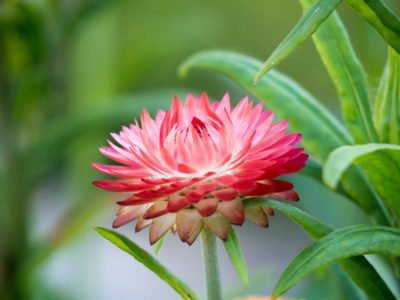

Composition and preparation of medicinal raw materials
For medicinal purposes, sand and meadow immortelle are usually used. Its inflorescences contain a large amount of flavonoids, glycosides, ascorbic acid, essential oils, resins, bitterness, coumarins, dyes, trace elements.
The collection of raw materials in the form of incompletely blossoming inflorescences is carried out at the beginning of flowering. Together with the basket, the peduncle is cut (up to 10 mm). Immediately after collection (no later than 4 hours), the inflorescences are laid out on racks in a shaded, ventilated place. Special dryers with temperatures up to 40 ° C can be used. Dried flowers exude a faint bitter-spicy aroma. They can be stored in paper bags or cloth bags for up to 3 years.
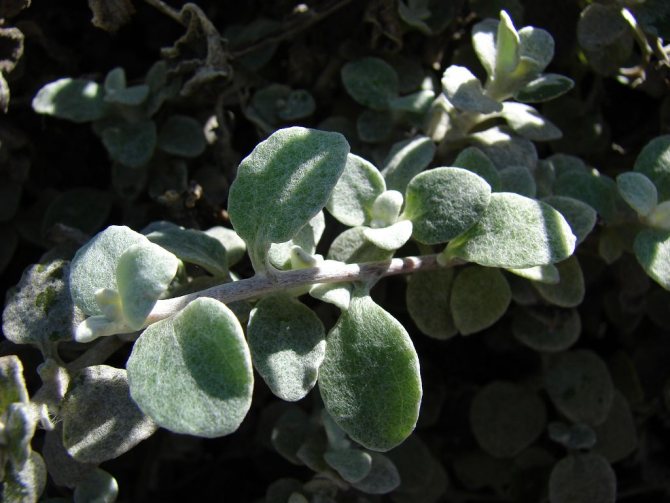

Reproduction of gelichrizum
Annual plants are propagated by seed, taking seeds that ripen after the end of the growing season. Seeds for seedlings are most often germinated in greenhouses. Already grown plants are planted in open ground.
They have good survival rate and bloom quickly. Seedlings should be planted only when the morning frosts will no longer threaten young plants with their harmful effects. The wells for planting are prepared in advance by introducing fresh soil into them, having previously mixed it with peat and sand.
Perennials are propagated by bush division. Seating parts of the bush should be in the areas selected in advance.
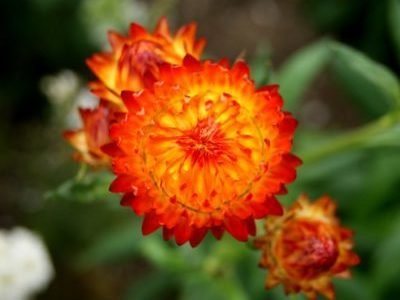

Agrotechnics
After the precursor has been removed, the area selected for the cmin is plowed to a depth of 14 cm, complementing the operation with simultaneous harrowing. After two weeks, the site is plowed deeply with a plow with skimmers. Later, when weeds appear, the field is cultivated two or three times. The same operation is carried out in the case of soil compaction. Later, in the autumn, the area is cultivated again. After that, the area is not harrowed. If there is no need to carry out semi-steam cultivation of the soil, the fall is left for the winter without cultivation.
In the spring, the area allocated for the cmin is treated twice with harrows. From the beginning of sowing, the field is cultivated in conjunction with light harrows. After that, the soil is leveled and compacted with rollers.
Tsmin is sown in calm weather, before winter or in spring, with converted vegetable seeders, on which the depth of travel of the limiting discs is set to no more than 0.5 cm. In the seeder, the springs on the rods are completely weakened, the rollers on the axle are turned in opposite directions. Seeds are sown into grooves no more than one centimeter deep. The seeding rate at 80–85 percent of seed germination should be 2–3 kg per hectare. The row spacing does not exceed 45 centimeters.
For your information! After a year of storage, immortelle seeds lose their germination and germination power by 70 percent.
Before sowing, cumin seeds are mixed with seeds of a lighthouse culture and a filler for uniform sowing. It is desirable to use superphosphate as a filler. Fertilizer is added in the range of 25 - 27 kg per hectare. The fertilizer is first sieved to obtain its grains up to 2 mm in diameter. This ensures even seed placement. After the end of sowing, the soil must be compacted with rollers.
If the weather is favorable, the soil is moist and its temperature is 6-8 ° C, cmin sprouts appear on the 10-25th day. They are still very tender, they do not tolerate weeds. During mechanized weeding of row spacings, the sprouts should not be sprinkled with soil.
Diseases and pests
Gelikhrizum practically does not get sick, however, pests like it very much, which include aphids and a caterpillar. To kill insects, the plant should be sprayed with insecticides such as Aktara, Binom and Bio Stop.
The only disease affecting the plant is white rust. You can fight it by spraying dried flowers with Bordeaux liquid.
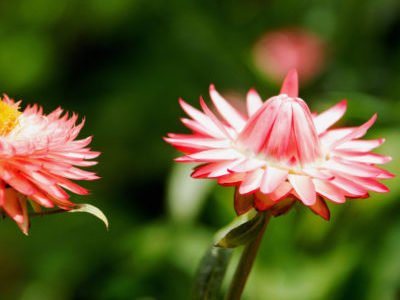

Industrial care of immortelle crops
This agricultural operation involves weed control, loosening of the soil in the aisles and fertilization. The first inter-row cultivation is carried out up to 5 cm deep, guided by the seedlings of the lighthouse culture. This work is performed with one-sided razor paws with shields installed on their risers. In the first year of plant development, 3-4 mechanized loosening is carried out, 2-3 times they are carefully weeded by hand so as not to pull out young shoots.
Plantations of the second and subsequent years of growing season harrow in early spring and at the same time clear the field from the remnants of dead plants. The operation is carried out carefully. The growing buds of the cmin can be easily damaged. Following the harrowing, the aisle is loosened. During the second cultivation (in the phase of regrowth of the cmina grass), the composition of a complete mineral fertilizer is added to the soil. Calculate for each hectare up to 30 kg of the introduction of the active substance. The next two or three cultivations are carried out until the time of closure of plant leaves and the appearance of generative organs.
The cmin plantation can be used for up to four years or more. It depends mainly on the care and preservation of the plants in winter. In snowy winters with low soil temperatures (minus 20–25 ° C), the cmin can freeze out completely, therefore, it is advisable to carry out snow retention in winter.
Seed plot of cmin
With the industrial cultivation of immortelle for medicinal raw materials, the presence of its own seeds is of great importance for the economy. To obtain it, seed plots are laid, which must be well processed and fertilized. Care for them is the same as for commercial crops (read above).
Before collecting the testes, when the seeds are brown and ripen, the aboveground mass is carefully mowed by 60–65 percent. It is better to do this with sickles early in the dew, since the seeds are easily separated from the inflorescences and crumble. The cut stems are tied into sheaves, taken under a canopy on the current. After the seeds are fully ripe, the sheaves are manually threshed. The resulting heap is collected in bags and ground. Then the seeds are carefully separated from the fluff on sieves with holes with a diameter of 0.25 mm and cleaned on cleaning machines. On average, 60–80 kg of seeds are obtained from one hectare. They are very small. The mass of 1000 pieces weighs no more than 0.05 grams.
Healing raw materials
The inflorescences (baskets) of immortelle begin to be harvested in the second year of the growing season. Cleaning can be done 2-3 times. Harvest by hand or using a special harvester. After harvesting, the raw materials are immediately brought into dryers, laid in a layer not higher than 3 cm. Drying is carried out at 45-50 ° C. In the process of drying, the grass is stirred several times a day; make sure that the inflorescences do not dry out and the baskets do not break.
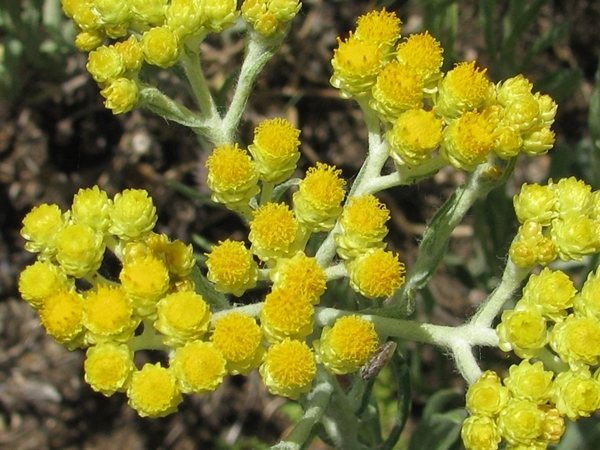

In the photo: Flowers of the immortelle
The yield of dry inflorescences of cmin is 9-13 centners per hectare. Raw materials are packed in bags weighing no more than 7 kg and stored on racks or pallets in a dry warehouse. The shelf life of raw materials is four years.
Immortelle medicinal properties and contraindications
Due to the large amount of nutrients contained in the immortelle, it is actively used in folk medicine and herbal medicine. The plant is rich in flavonoids, vitamins, mineral salts, fatty acids, tannins, carotenes, glycosides and esters.
Essential oil helps with stress, nervous disorders. It is also an excellent natural antidepressant.
In cosmetology, immortelle oil is used to relieve inflammation, regenerate the skin and fight acne. The oil is suitable for people suffering from psoriasis and eczema. It helps to reduce scars and skin pigmentation.
Immortelle is an effective antispasmodic. It is used to treat the intestines and stomach. It helps to get rid of diseases of the biliary system and liver. Also, the plant is a natural immunomodulator, so its infusions and decoctions are often used for colds.
It is not recommended to take the immortelle in case of intolerance of its components, high acidity and obstructive jaundice. With extreme caution, it should be used for hypertension and atherosclerosis.


Daisy-flowered immortelle (Helichrysum bellidioides)
A creeping evergreen perennial with a white pubescent stem (at a young age, later - with a smooth, reddish-brown) up to 15 cm high and up to 60 cm wide.
Daisy-flowered immortelle. Photo from the site stridvall.se
He comes from New Zealand. Leaves obovate, small, up to 1 cm long, white below. Capitate inflorescences up to 3 cm in diameter, white, solitary, papery, similar to chamomile baskets; located on straight peduncles covered with leaves; bloom from late spring to summer.
Daisy-flowered immortelle. Its 'Silver Gushion' in a pot. Photo from prairiebreak ..
The nuances of growing In the English reference literature, its winter minimum is given as a standard: -15 ° С, so this immortelle can definitely be tried to grow with a shelter in central Russia. It should be remembered that he, like lavender, does not like stagnant waterlogging. Accommodation in the country It is better to plant a tall stationary container in a high bed or flower garden on the terrace so that it does not get wet during the winter. Daisy-flowered immortelle in a stationary container in the background.
When planted and trimmed tightly, it can be used as a curb plant. Suitable for a gravel garden.
Immortelle application in traditional medicine
Infusions and decoctions based on immortelle are used in the treatment of many ailments. Most often they are used for skin diseases, hypotension, as a choleretic agent and for the prevention of liver diseases. Below are some effective recipes to combat these ailments.
Tincture of immortelle for eczema and psoriasis
To prepare the tincture, you should take 1 tbsp. a spoonful of dried flowers or 2 tbsp. fresh spoons. Then put them in a jar and pour half a glass of alcohol there, then cover the container with a lid and put it in a dark place.
After a week, the tincture must be taken out, drained and taken 20 drops 4 times a day for a month with eczema and psoriasis.
Choleretic infusion of immortelle
For cooking, you should take 3 tbsp. tablespoons of dried flowers of cmin, pour them into a saucepan and pour a glass of boiling water. Then boil the resulting mixture in a water bath for half an hour.
The finished broth must be cooled and brought to the original volume with boiled water, and then filtered. It should be taken warm in half a glass three times a day for two weeks.
Tincture of immortelle with hypotension
To increase the pressure to the standard values, it is necessary to take 30 milliliters of this infusion three times a day for a month.
You can prepare it as follows: take 10 grams of dry immortelle raw materials, pour 200 milliliters of boiling water and leave for about an hour. After which the infusion can be taken.
Preventive decoction of immortelle for the liver
To prepare the broth, you should take 1 tbsp. l of dry immortelle and pour 200 milliliters of boiling water over it, then boil in a water bath for half an hour.
When the broth has cooled, it should be drained and diluted with boiled water to its original volume. Take the broth should be 125 grams three times a day for two weeks.
Before taking any of the above remedies, in order to avoid undesirable consequences, you should consult with your doctor.
Decorative use
The exquisite charm of immortelles with airy greenery and bright colors can hardly be overestimated. They are used in mixed flower beds, near buildings or fences. Also, the plant is suitable for decorating rockeries and rock gardens. The flower is very popular in floristry. It is often used in wreaths, garlands and winter bouquets.


Not fully blossoming buds together with the stem are cut in the fall. The leaves are completely removed. Drying is carried out in an upright position with the head down. Do not be afraid to keep an immortelle at home. While dry, dead flowers are wary, this is just prejudice. Tsmin is considered the guardian of youth and attractiveness. He also protects sleep, fights ailments, endows the owner with courage and courage, and also teaches us to accept every day with joy.
Biochemical composition
The plant contains a unique list of medicinal substances. The presence of valuable essential oil provides a pronounced aroma and bitter taste. Especially there is a lot of it in the inflorescences. In addition, immortelle flowers are enriched with steroid compounds, dyes and tannins, useful flavonic acids.
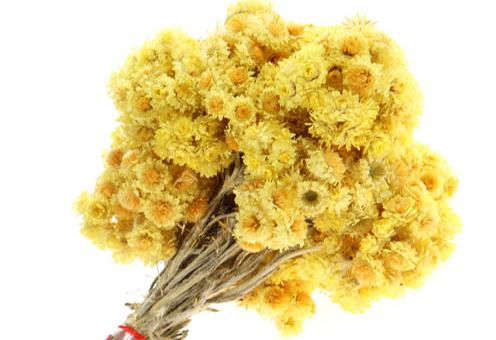

Useful properties are due to the presence of a number of vitamins and minerals. Experts have identified the following components: cresol, fatty acids, ascorbic acid, aglycone, glucose and many other medicinal substances.
What diseases are immortelle used for?
Means that are made on the basis of sandy immortelle are used in the treatment of various pathologies, for example:
- cholecystitis;
- hepatitis;
- stones in the gallbladder;
- atherosclerosis;
- bleeding;
- gastritis;
- colitis;
- gout;
- rheumatism;
- inflammatory process in the sciatic nerve;
- neuralgia;
- kidney stones;
- renal failure.
Also, folk medicines are used for skin pathologies, tissue swelling, pain.
Immortelle photo
Read here! Treatment of tuberculosis with folk remedies - simple ways to treat lungs and a review of the most effective folk remedies (95 photos)
Please repost
1+
Application
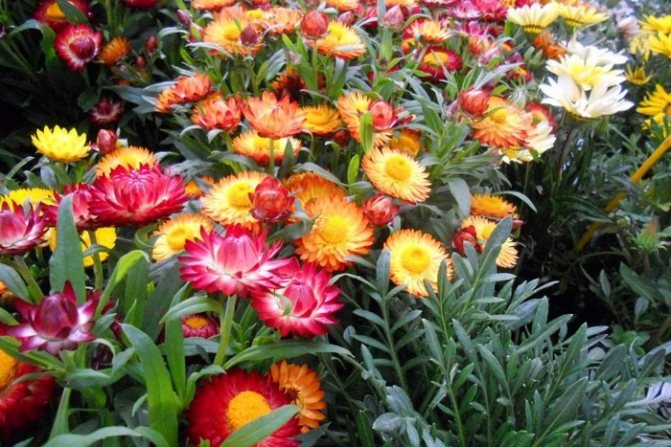

Low varieties of immortelle are great for growing in containers. High varieties for cutting and creating dry bouquets. Cut when the flowers are not fully open. Dried flowers can be used for dry compositions, flower baskets can also be cut off and glued to the base, making a wreath on the front door.
Briefly about the plant
It is important to know the description of the plant in order to plant and grow it correctly. Helichrysum flowers can be found in the Caucasus, Russia, Belarus and Ukraine.
The plant grows on sandy loose soils, dry mountain heights, in pine forests and forest glades. Gelichrizum reproduces well and forms thickets. The height of the flower is no higher than 50 centimeters. It has highly pubescent and leafy stems.The leaves have pointed tops. Flowers consist of baskets of lemon-yellow hue. The plant blooms actively in summer. To decorate the summer cottage, helihrizum garden flowers are planted. For rapid development and beautiful flowering, the plant must be fed and watered.
Indications


Herbal preparations based on dried flowers are successfully used in urology. They relieve pain, eliminate spasms and exhibit disinfecting properties. Immortelle flowers are indispensable for gastrointestinal pathologies. The use of decoctions helps to restore peristalsis and get rid of chronic constipation.
The plant cleans the blood vessels of cholesterol plaques and helps to increase the absorption of beneficial elements. Helichrysum flowers, the medicinal properties of which include hemostatic qualities, help with skin lesions, bruises and promote rapid healing of wounds. Tsmin is credited with antihistamine properties. It is used to treat and prevent various types of helminths. It prevents their further occurrence.
How the plant is used in cosmetology
In cosmetology, the sandy immortelle is also widely used. After all, it helps to fight inflammatory processes of the skin, has an antiseptic effect. Therefore, products based on it allow you to treat acne, acne, which often appear with an oily type of dermis.
The plant also produces an antifungal effect. Therefore, it is used to treat nail and skin fungus, as well as to eliminate dandruff.
Often, the immortelle is included in the composition of various masks, creams and serums for mature skin, as it regenerates and restores cells of the integument, creates a rejuvenating effect.
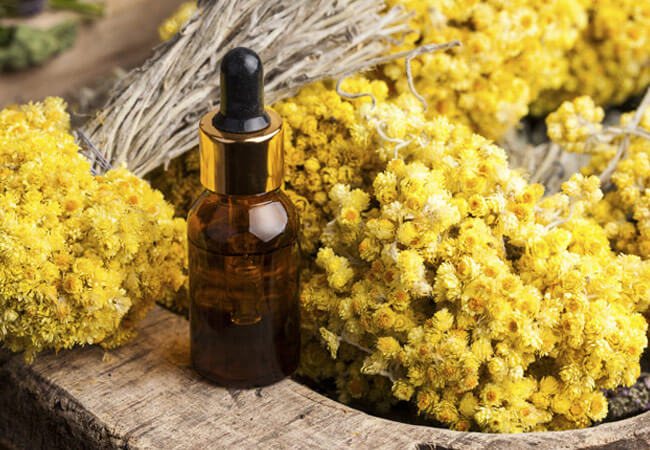

Helichrysum essential oil
origin of name
Now we know what immortelle herb looks like. But where does he get such a loud name? The plant received this name due to its vitality: even a plucked immortelle flower does not fade and retains its beauty.


Among the people, the herb is known as dried flowers, tsmin, golden. She also has a Latin name - helichrizum arenarium ("golden sun"). Again, as can be judged from the photo of the plant, it is not in vain that the immortelle has earned such a loud name - its petals really differ in a rather bright yellow / orange tint, which is the special attractiveness of the semi-shrub plant.
This herb is often found on the territory of Belarus, Ukraine, Russia. The sandy immortelle, a photo of which will help you find a plant in the countryside, prefers to grow on forest edges and meadows.
Growing seedlings
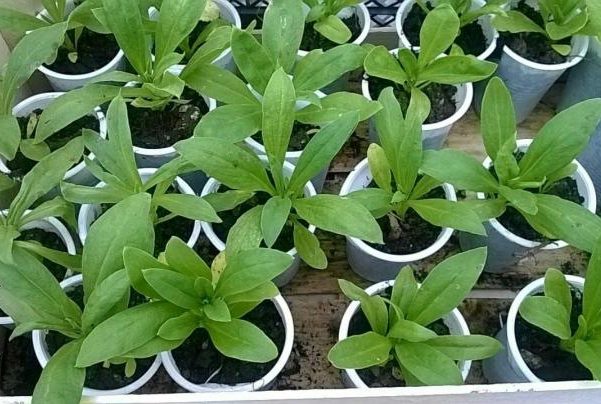

Sowing gelichrizum is carried out in the month of March. 3-4 seeds are sown in the hole. Watered and then covered with polyethylene to create a greenhouse effect for better germination. After about 2 = 5 days, the first shoots will appear. Seedlings are thinned out after they get stronger. Can be sown in peat cups. One seed is spent for each.
From time to time, the seedlings are ventilated and watered. The temperature, favorable environment for germination, can fluctuate between 15-22 degrees Celsius.
Contraindications
When a person develops a disease such as obstructive jaundice, the use of immortelle is contraindicated.
Since a large amount of substances accumulated in the body due to immortelle will lead to liver failure, increased blood pressure. Balance is needed everywhere, do not forget about it.


Remember that a doctor's consultation must precede any self-medication!
Plant varieties


The immortelle is of different types. The most popular are the following varieties:
- Gelichrizum monstrozum has a high stem and numerous double round flowers;
- Gomphrene globose forms a branched bush, the flowers of which are pink, crimson or orange;
- Statice sinuata is a very beautiful flower with bright colors and pretty leaves;
- Sandy immortelle has simple, erect, numerous leaves, pubescent on top. Small flowers. Have a golden yellow or orange tint;
- To decorate rock gardens and rockeries, coral varieties of immortelle are planted. Their height is 24 centimeters. On branches sticking out in different directions, there are many small leaves with gray pubescence. The inflorescences themselves are small in size, painted white or yellow;
- A margarita-flowered variety of Helichrizum grows to a height of 8 centimeters. The bushes bloom in early summer in the form of a rug with small pubescent gray leaves. The short stalks of the plant are dotted with dry white inflorescences. Bushes grow very quickly and can reach a diameter of 50 centimeters;
- The most original type of immortelle is the Milford variety. The reed flowers of the perennial are painted white on the inside, and on the outside - pink-carmine. When the flowers open, white clouds can be seen. Blooms from late spring to early autumn;
- Gelikhrizum selago has creeping stems on which shiny whorled leaves of a dark green color grow. The perennial has small baskets with white and yellow flowers;
- A perennial variety called Tien Shan blooms with yellow inflorescences. In appearance, it resembles a sandy plant variety;
- A narrow-leaved variety of gelichrizum grows to a height of 30 centimeters. It has silvery white leaves. With this variety, flower growers decorate the borders.
Treatment with immortelle drugs
The variety of medicinal properties of yellow immortelle determines the variety of ways of its use.
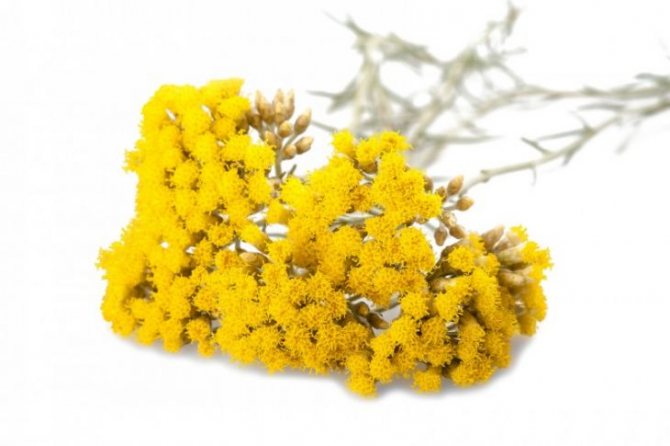



Thrombophlebitis treatment - classification and symptoms of thrombophlebitis. Treatment options with drugs and alternative methods (110 photos)

How to treat lichen - an overview of the most effective drugs at home (115 photos and videos)


Bitter wormwood medicinal properties - treatment and cleansing of the body with wormwood. Tips for collecting, storing and preparing medicines (95 photos)
Gastroenterology in its diversity is generated by tasty and unhealthy food, fatty, flavored with alcohol, which is difficult to refuse, especially on numerous holidays.


Refraining from taking it requires tremendous willpower, and the friends and relatives around us drown out this feeling with insults and persuasion, demanding to poison ourselves with deliciously smelling, beautifully designed, salivating and appetizing dishes.
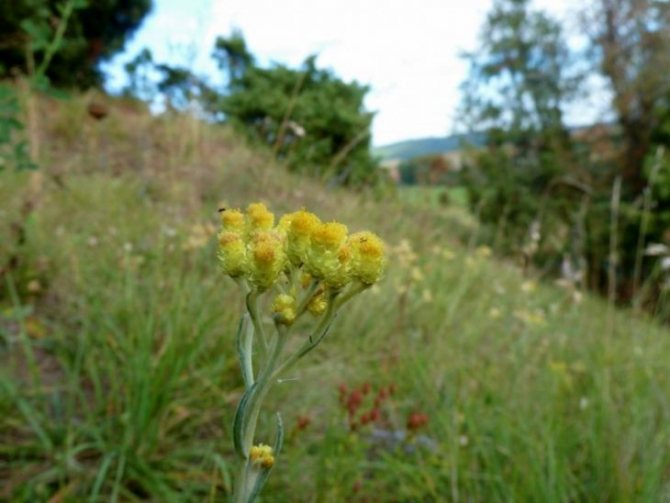

In the end, with age, it becomes necessary to see a doctor or engage in herbal medicine. The inflorescences of the immortelle are a panacea that will help until the disease from gluttony finally destroys the body.
Traditional recipes, tested for centuries, help to overcome the aforementioned diseases. It should be remembered that the treatment process is long, and the recipes and methods of their application are selected for each organism individually.


Offered by traditional medicine, they are general in nature, and the patient must monitor and adjust their action daily from the beginning of the admission.
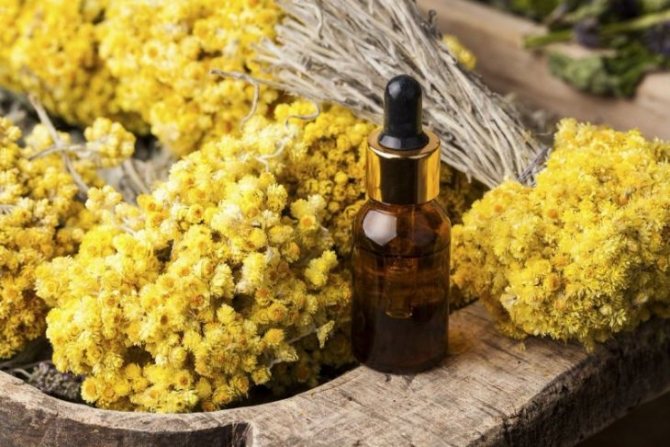

Pharmacological properties
Useful properties of the sandy immortelle plant:
- Increases the production of bile and juice in the stomach.
- Increases the tone of the tissues of the gallbladder, helps bile flow better.
- Produces an antispasmodic effect on the smooth muscles of the gallbladder.
- Changes the viscosity and composition of bile, increasing the cholesterol ratio.
- Improves the process of food digestion.
- Activates the work of the pancreas.
- Expands blood vessels.
- Suppresses inflammatory processes in the body.
- Helps fight pathogens.
Also, flowers do an excellent job with nervous tension, anxiety, and has a calming effect on the human body.
Summing up
The immortelle is a flower that can be found quite often in the wild, but this does not negate the fact that it can also be grown in your garden. It is unpretentious, so it will not be difficult. It is important to remember that there are perennial varieties, but there are also “one-year-olds”, which will have to be planted again annually.
Perhaps the main advantage of this flower is its healing properties, but it also has a pleasant "appearance", which allows you to decorate your site with it.

